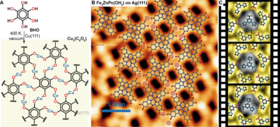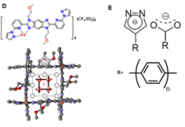Surface-Based Self-Assembly of Coordination Nano-Architectures
custom-designed molecular bricks • near–surface conditions • spectroscopy techniques
J. V. Barth,(a) S. Klyatskaya,(b) P. Knecht,(a) D. Meier,(a) A. C. Papageorgiou,(a) M. Ruben,(b) N. Sbei,(b) N. Suryadevara(b)
(a) Physics Department E20, Technical University of Munich, 85748 Garching
(b) Institute of Nanotechnology, Karlsruhe Institute of Technology (KIT), 76344 Eggenstein-Leopoldshafen
We explored on-surface, in vacuo synthesis protocols of functional coordination networks. These included exploration of two dimensional metal-catecholate MOFs and afforded networks with previously unreported coordination nodes of (Scheme 1A1 and 1B). En route to coordination networks featuring spin-crossover complexes, we discovered the spontaneous assembly of a complex and dynamic one-component system, a rigid kagome lattice with each pore occupied by a guest molecule on Ag(111) (Scheme 1C). On-going investigations look into applying similar protocols for the fabrication of fractal coordination networks.
Moreover, we engineered coordination networks providing different magnetic features, incorporating (i) Fe(II) based spin-crossover (SCO) (Scheme 1D2) or (ii) pyrazole molecules functionalized with transition metals or lanthanides molecular magnetism (Scheme 1E). Enhancement of electric conductivity will be delivered by inclusion of photopolymerizable moieties in the MOF building block.
References
(1) Zhang, R. et al. On-surface Synthesis of a Semiconducting 2D Metal–Organic Framework Cu3(C6O6) Exhibiting Dispersive Electronic Bands. Angew. Chem., Int. Ed. 2020, 59, 2669-2673.
(2) N. Suryadevara, Magnetic Molecular Architectures: From Mononuclear to Polynuclear, Dissertation, Institute of Nanotechnology, Karlsruher Institut für Technologie (KIT), Karlsruhe, 2020
Interested in finding out more? Click here to learn more about this overarching COORNETs Phase II team and project.

